BIN (Bank Identification Number) или БИН по русски (Банковский Идентификационный Номер), это номер, который даёт полную информацию о банке, он является частью номера карты, и используется для идентификации банка в рамках карточной платёжной системы при авторизации, процессинге и клиринге.
Банковский Идентификационный Номер (БИН, BIN) карты состоит из 6 цифр, с которых начинается номер любой банковской карты, то есть БИН банка обязательно включён в номер банковской карты.
Нужна ли информация о БИН-ах держателям банковских карт, и насколько она для них полезна, сказать сложно, тем более, что в открытом доступе БИН-ы карт банков практически не встречаются. Эта часть номера карты при оформлении переводов и платежей отдельно от всего номера карты не заполняется.
Вот так БИН можно выделить в номере карты, который указывается на карте:

БИН карты
БИН можно выделить в номере карты и так:
1234 5678 9000 0000
Каждая из 6 цифр БИН-а в номере карты имеет своё, конкретное значение. БИН даёт полную и исчерпывающую информацию о банке-эмитенте и применяемой им платёжной системы, т.е. это банковский идентификатор эмитента (банка), выпустившего карту. Так что же означают эти цифры?
Структура БИН карты выглядит так:
- Первая цифра БИН – это цифра, которая указывает на вид платёжной системы, которая обслуживает выпущенную карту и бывает следующей:
- VISA – 4;
- American Express – 3,
- MasterCard – 5,
- Maestro — 3, 5 или 6,
- JCB International — 3,
- China UnionPay — 6,
- УЭК — 7.
Формат номера карты регулируется ИСО/МЭК 7812-1 (выдаётся системой SWIFT).
- Вторая-четвёртая цифры – это номер банка, который формируются платёжной системой. Так, например, на банковских картах Сбербанка России 2,3 и 4 цифры в основном — 276, а на картах Альфа Банка — 234
- Пятая и шестая цифра BIN – дополнительный идентификатор продукта, присваивается согласно категории банковского продукта, это значение также позволяет определить по ряду дополнительных признаков банк, выдавший карту.
Итак, зная первые 6 цифр номера карты, т.е. зная банковский идентификационный номер можно узнать следующую информацию:
- Используемую платёжную систему, хотя на карте и так всегда присутствует логотип этой платёжной системы. Кстати, вид платёжной системы обязательно должен совпадать с логотипом. Наиболее распространёнными на территории России пока считаются следующие платёжные системы:

Логотип Visa
Логотип Maestro
Логотип MasterCard - Банк, выпустивший карту. Но и эта информация на банковской карте имеется в виде логотипа банка-эмитента . Так, например, логотипы на картах:
- На картах Сбербанка России
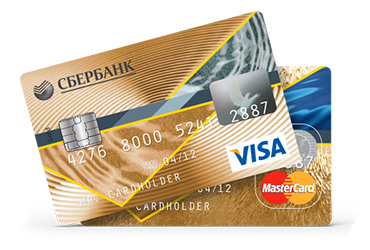
Карта Сбербанка - На картах Альфа Банка
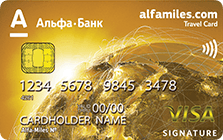
Карта Альфабанка - На картах Россельхозбанка

Карта Россельхозбанка
- На картах Сбербанка России
- Вид карты (Electron, Classic, Gold, Maestro, Standard, Platinum);
БИН используется при переводах между картами — для идентификации банка в рамках карточной платёжной системы при авторизации, процессинге и клиринге.
What Is a Bank Identification Number (BIN)?
The term bank identification number (BIN) refers to the first four to six numbers on a payment card. This set of numbers identifies the financial institution that issues the card. As such, it matches transactions to the issuer of the card being used. BINs can be found on various payment cards, including credit cards, charge cards, and debit cards.
The BIN system helps financial institutions identify fraudulent or stolen payment cards and can help prevent identity theft.
Key Takeaways
- A bank identification number is the first four to six numbers that appear on payment cards.
- BINs are found on credit cards, charge cards, prepaid cards, debit cards, and gift cards.
- The BIN helps merchants evaluate and assess their payment card transactions.
- The number allows merchants to accept multiple forms of payment and allows transactions to be processed faster.
- BINs can help financial institutions identify fraudulent or stolen cards and prevent identity theft.
How Bank Identification Numbers (BINs) Work
The bank identification number is a numbering system developed by the American National Standards Institute (ANSI) and the International Organization for Standardization (ISO) to identify institutions that issue payment cards. The ANSI is a nonprofit organization (NPO) that creates business standards in the U.S. while the ISO is an international nongovernmental group that creates standards for various industries.
All payment cards come with a BIN number. This is a set of four to six numbers randomly assigned to debit cards, credit cards, charge cards, gift cards, electronic benefit cards, and other payment cards. The number is embossed on the front of the card and appears in print just below as well. The first digit specifies the major industry identifier. The digits that follow specify the issuing institution or bank. For example, Visa credit cards start with a four, which falls under the banking and financial category.
When a customer makes an online purchase, the customer enters their card details on the payment page. After submitting the first four to six digits of the card, the online retailer can detect which institution issued the customer’s card including:
- The card brand or Major Industry Identifier, such as Visa, MasterCard, American Express, and Diner’s Club
- The card level, such as corporate or platinum
- The card type
- The issuing bank’s country
When the customer initiates a transaction, the issuer receives the authorization request to verify if the card and account are valid and whether the purchase amount is available. This process results in the charge being either approved or denied. Without a BIN, the credit card processing system would be unable to determine the origin of the customer’s funds and would be unable to complete the transaction.
The BIN number allows merchants to accept multiple forms of payment and allows faster processing of transactions.
What Are BINs Used For?
BINs have a variety of useful applications. The primary purpose is to allow merchants to evaluate and assess payment card transactions.
They also allow merchants to identify originating banks along with their address and phone number, and whether issuing banks are in the same country as the device used to make the transaction. It also verifies the address provided by the customer.
But more importantly, the numbering system helps identify identity theft or potential security breaches by comparing data, such as the address of both the issuing institution and the cardholder.
Benefits of a BIN
BINs are used to increase the speed and efficiency of checkout when paying with a debit or credit card. As a customer swipes their card, the store’s payment processor scans the BIN on their card and validates their account with the card issuer. This also determines if the transaction is authorized and compliant with any relevant national laws.
Example of a Bank Identification Number (BIN)
Here’s a hypothetical example to show how BINs work. Let’s say a customer uses their bank card at the gas pump when they fill up their tank. Once they swipe the card, the system scans the BIN to detect the specific institution that issued the card.
An authorization request is then put on the customer’s account. The request is authorized within a few seconds, and the transaction is approved if the funds are available or declined if the customer doesn’t have enough funds to cover the charge.
What Is a Bank Identification Code?
A bank identification code, which is also known as a bank identifier code, is a special code made up of eight to 11 digits. It is an international standard that identifies a bank or non-financial institution whenever someone makes an international purchase or transaction. A BIC can be connected or non-connected. The former is part of the SWIFT network and are called SWIFT codes while the latter is generally used for reference only.
How Do You Use a Bank Identification Number?
Consumers generally don’t use BINs but it is important to know what they mean. The first digit is the major industry identifier while the remaining digits specify the issuing financial institution.
When you make a purchase or transaction, the issuing institution receives a request for authorization. This request attempts to verify the legitimacy of the account and whether the funds are available. If everything checks out, the transaction is approved. If not, the institution declines it.
What Is BIN Scamming?
BIN scamming is a fraud scheme. It occurs when a fraudster calls impersonating someone from your bank, claiming that your account information has been compromised. The scammer may give you information to try to gain your trust. Once you’re hooked, they try to confirm the number of your card and begin by asking where you bank.
When they have that information, they give you the bank identification number and ask that you confirm the remaining digits on the card along with any other information they can get from you.
Why Are BIN Numbers Important?
BINs allow merchants to accept multiple payments at the same time. They also make payment processing much faster.
BINs help banks and financial institutions identify cards that have been compromised or stolen because it provides information about the type of card being used, the type of bank, and other information about the issuing company and cardholder.
The Bottom Line
Bank identification numbers are used to identify which payment cards belong to which issuing financial institution. But aside from that, they help facilitate financial transactions and ensure that consumers are protected from identity theft and fraud. That’s why it’s so important to keep your financial information, including your BIN, confidential.
Remember, your bank will never call or send you an email to inform you that your account information has been compromised. If you ever receive a call, don’t engage with the scammer. Instead, hang up and notify your bank. You can also file a complaint with the FTC on the agency’s website.
What Is a Bank Identification Number (BIN)?
The term bank identification number (BIN) refers to the first four to six numbers on a payment card. This set of numbers identifies the financial institution that issues the card. As such, it matches transactions to the issuer of the card being used. BINs can be found on various payment cards, including credit cards, charge cards, and debit cards.
The BIN system helps financial institutions identify fraudulent or stolen payment cards and can help prevent identity theft.
Key Takeaways
- A bank identification number is the first four to six numbers that appear on payment cards.
- BINs are found on credit cards, charge cards, prepaid cards, debit cards, and gift cards.
- The BIN helps merchants evaluate and assess their payment card transactions.
- The number allows merchants to accept multiple forms of payment and allows transactions to be processed faster.
- BINs can help financial institutions identify fraudulent or stolen cards and prevent identity theft.
How Bank Identification Numbers (BINs) Work
The bank identification number is a numbering system developed by the American National Standards Institute (ANSI) and the International Organization for Standardization (ISO) to identify institutions that issue payment cards. The ANSI is a nonprofit organization (NPO) that creates business standards in the U.S. while the ISO is an international nongovernmental group that creates standards for various industries.
All payment cards come with a BIN number. This is a set of four to six numbers randomly assigned to debit cards, credit cards, charge cards, gift cards, electronic benefit cards, and other payment cards. The number is embossed on the front of the card and appears in print just below as well. The first digit specifies the major industry identifier. The digits that follow specify the issuing institution or bank. For example, Visa credit cards start with a four, which falls under the banking and financial category.
When a customer makes an online purchase, the customer enters their card details on the payment page. After submitting the first four to six digits of the card, the online retailer can detect which institution issued the customer’s card including:
- The card brand or Major Industry Identifier, such as Visa, MasterCard, American Express, and Diner’s Club
- The card level, such as corporate or platinum
- The card type
- The issuing bank’s country
When the customer initiates a transaction, the issuer receives the authorization request to verify if the card and account are valid and whether the purchase amount is available. This process results in the charge being either approved or denied. Without a BIN, the credit card processing system would be unable to determine the origin of the customer’s funds and would be unable to complete the transaction.
The BIN number allows merchants to accept multiple forms of payment and allows faster processing of transactions.
What Are BINs Used For?
BINs have a variety of useful applications. The primary purpose is to allow merchants to evaluate and assess payment card transactions.
They also allow merchants to identify originating banks along with their address and phone number, and whether issuing banks are in the same country as the device used to make the transaction. It also verifies the address provided by the customer.
But more importantly, the numbering system helps identify identity theft or potential security breaches by comparing data, such as the address of both the issuing institution and the cardholder.
Benefits of a BIN
BINs are used to increase the speed and efficiency of checkout when paying with a debit or credit card. As a customer swipes their card, the store’s payment processor scans the BIN on their card and validates their account with the card issuer. This also determines if the transaction is authorized and compliant with any relevant national laws.
Example of a Bank Identification Number (BIN)
Here’s a hypothetical example to show how BINs work. Let’s say a customer uses their bank card at the gas pump when they fill up their tank. Once they swipe the card, the system scans the BIN to detect the specific institution that issued the card.
An authorization request is then put on the customer’s account. The request is authorized within a few seconds, and the transaction is approved if the funds are available or declined if the customer doesn’t have enough funds to cover the charge.
What Is a Bank Identification Code?
A bank identification code, which is also known as a bank identifier code, is a special code made up of eight to 11 digits. It is an international standard that identifies a bank or non-financial institution whenever someone makes an international purchase or transaction. A BIC can be connected or non-connected. The former is part of the SWIFT network and are called SWIFT codes while the latter is generally used for reference only.
How Do You Use a Bank Identification Number?
Consumers generally don’t use BINs but it is important to know what they mean. The first digit is the major industry identifier while the remaining digits specify the issuing financial institution.
When you make a purchase or transaction, the issuing institution receives a request for authorization. This request attempts to verify the legitimacy of the account and whether the funds are available. If everything checks out, the transaction is approved. If not, the institution declines it.
What Is BIN Scamming?
BIN scamming is a fraud scheme. It occurs when a fraudster calls impersonating someone from your bank, claiming that your account information has been compromised. The scammer may give you information to try to gain your trust. Once you’re hooked, they try to confirm the number of your card and begin by asking where you bank.
When they have that information, they give you the bank identification number and ask that you confirm the remaining digits on the card along with any other information they can get from you.
Why Are BIN Numbers Important?
BINs allow merchants to accept multiple payments at the same time. They also make payment processing much faster.
BINs help banks and financial institutions identify cards that have been compromised or stolen because it provides information about the type of card being used, the type of bank, and other information about the issuing company and cardholder.
The Bottom Line
Bank identification numbers are used to identify which payment cards belong to which issuing financial institution. But aside from that, they help facilitate financial transactions and ensure that consumers are protected from identity theft and fraud. That’s why it’s so important to keep your financial information, including your BIN, confidential.
Remember, your bank will never call or send you an email to inform you that your account information has been compromised. If you ever receive a call, don’t engage with the scammer. Instead, hang up and notify your bank. You can also file a complaint with the FTC on the agency’s website.
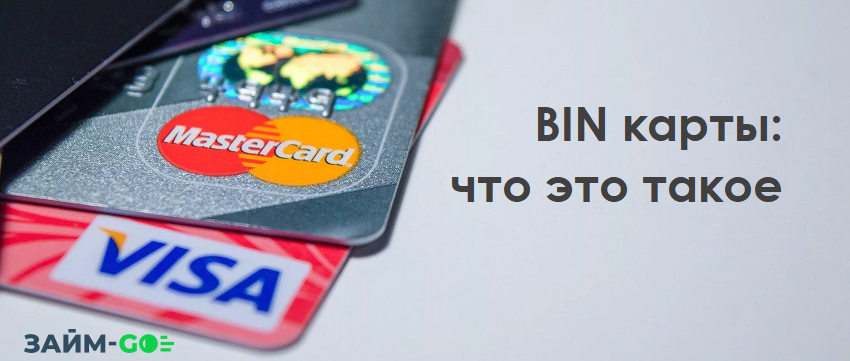
У каждой банковской карты есть уникальный номер. Он генерируется по определенному принципу. Начало номера (БИН карты) содержит важную зашифрованную информацию. Мы расскажем, как провести расшифровку и проверить BIN.
Содержание
- Что такое БИН карты
- Расшифровка БИН
- Как проверить карту по БИНу
- Для чего нужна расшифровка идентификатора
- Безопасно ли сообщать BIN третьим лицам
Что такое БИН карты
Английская расшифровка аббревиатуры BIN — это Bank Identification Number. На русский язык она переводится как «Банковский Идентификационный Номер».
БИН карты — это первые 6 цифр уникального номера. Узнать эти цифры можно, посмотрев на лицевую сторону пластика. Можно узнать номер в личном кабинете клиента или через мобильное приложение. По действующему стандарту Банка России, БИН входит в число регистрационных данных. Номер может понадобиться при контакте с государственными органами, при подтверждении электронных платежей. Запросить банковский идентификатор могут как живые люди, так и боты.
Сообщать BIN можно, не опасаясь за безопасность. По шести цифрам нельзя получить доступ к деньгам, которые хранятся на счете. Но не называйте никому все цифры с лицевой стороны.
Расшифровка БИН
| Цифры по порядку | Значение | Расшифровка |
| Первая | Название платежной системы | 3. Американ Экспресс. 4. Visa. 5. MasterCard. 6. Maestro |
| Вторая, третья, четвертая | Название банка-эмитента. Код государства, где заключен договор на обслуживание. | Например: 276. Сбер (РФ). 234. Альфа (РФ) |
| Пятая, шестая | Тип карты: дебетовая или кредитка. Название пакета банковских услуг. | Дебетовая, кредитная и т.д. |
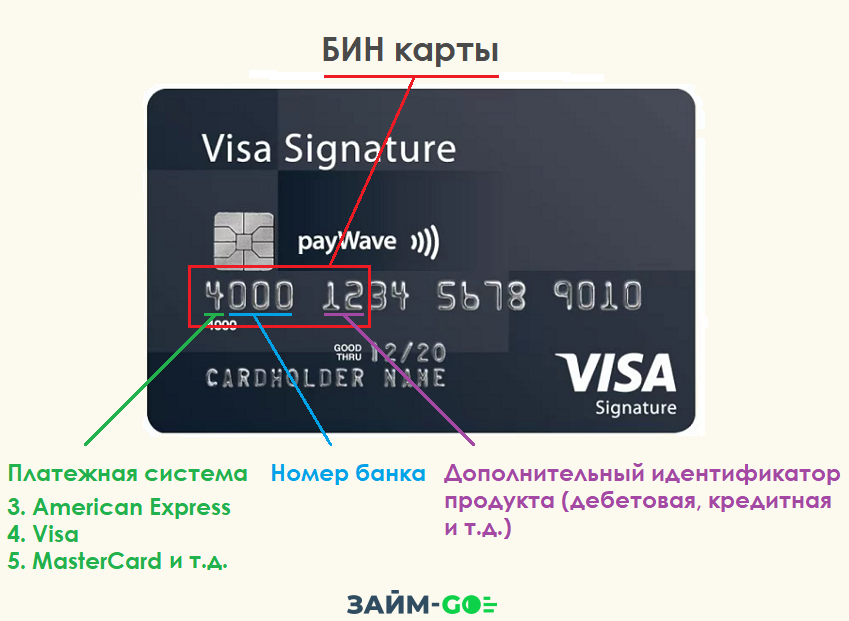
Как проверить карту по БИНу
Для получения информации о карте и точной расшифровки кода можно воспользоваться онлайн сервисом. Например:
- BIN Database bindb.com
- Pay Space
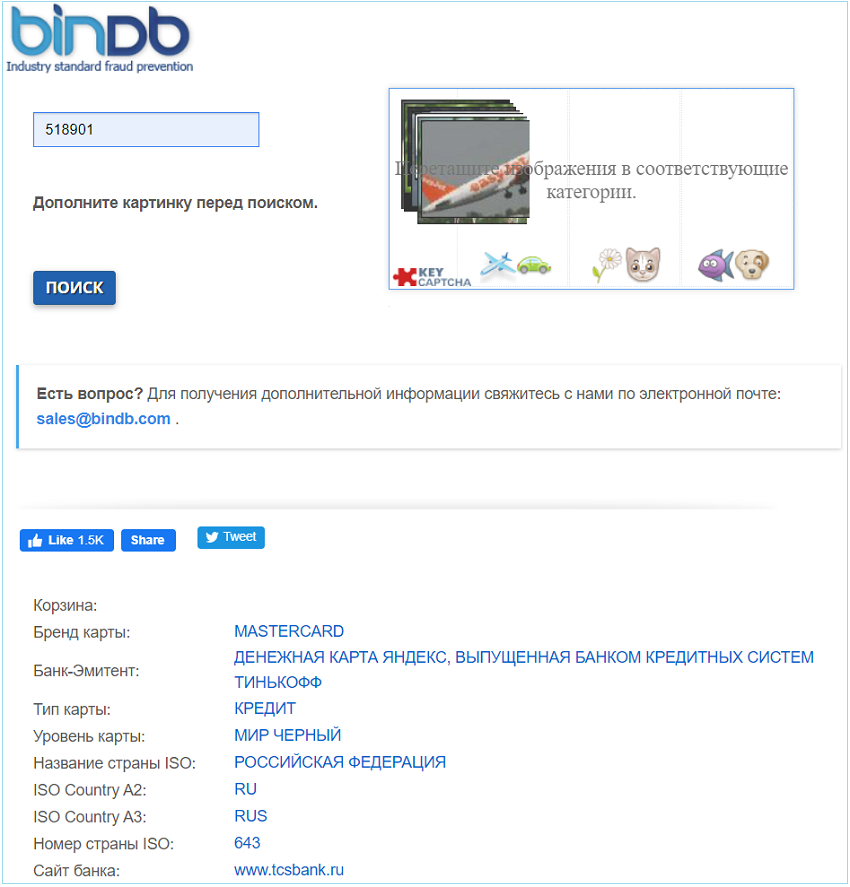
Это самый простой и быстрый способ проверить карту по БИН, узнать какой банк выпустил карточку. Для расшифровки через приложение понадобится ввести капчу. Подобная мера введена для защиты от ботов.
Для чего нужна расшифровка идентификатора?
Расшифровка банковского кода не нужна самому владельцу карты. Все сведения, которые можно получить из первых шести цифр для него очевидны. Тип платежной системы, название эмитента и пакет услуг указываются на лицевой стороне пластика. Эта информация дублируется в договоре с банком.
Расшифровка кода может быть интересна только третьим лицам. Чаще всего коды спрашивают по одной из двух причин:
- Сбор статистики о банковских продуктах.
- Проверка благонадежности человека.
Статистика необходима юридическим лицам: магазинам или другим коммерческим предприятиям. Если большое число клиентов пользуется услугами конкретного банка, имеет смысл заключить с ним договор. Это позволит фирме платить меньшую комиссию за обслуживание клиентов банка.
Проверять информацию могут физические и юридические лица. Расхождение номера со словами клиента или продавца — повод усомниться в его благонадежности и отменить сделку. Например, если продавец говорит, что живет в США, но карта выпущена в стране третьего мира, имеет смысл отменить сделку и не переводить деньги.
Чаще всего БИН обрабатывается в автоматическом режиме. Обработка происходит во время переводов между счетами.
Безопасно ли сообщать BIN третьим лицам?
Вводить или называть первые цифры можно, не опасаясь за безопасность карты. Если какой-либо сервис попросит ввести банковский идентификатор полностью, закройте этот сайт.
Вводить все данные с лицевой стороны, а также CVV/CVC код, можно только для оплаты покупок в интернете. Эту информацию должен обрабатывать бот. Полные данные карты нельзя называть вслух третьим лицам, даже сотрудникам банка.
Помните, что если хищение произошло по вине держателя карты, банк не будет возмещать деньги за свой счет. Компенсация потери возможна только после поимки мошенников и суда над ними, что случается редко.
Заключение
БИН — это идентификатор банка и платежной системы. Он используется для проверки данных о карточке. Проверка BIN применяется для обеспечения безопасности платежных операций. Если клиент называет первые 6 цифр, это позволяет идентифицировать его карточку. Но этих данных недостаточно для мошеннических действий со счетом.
